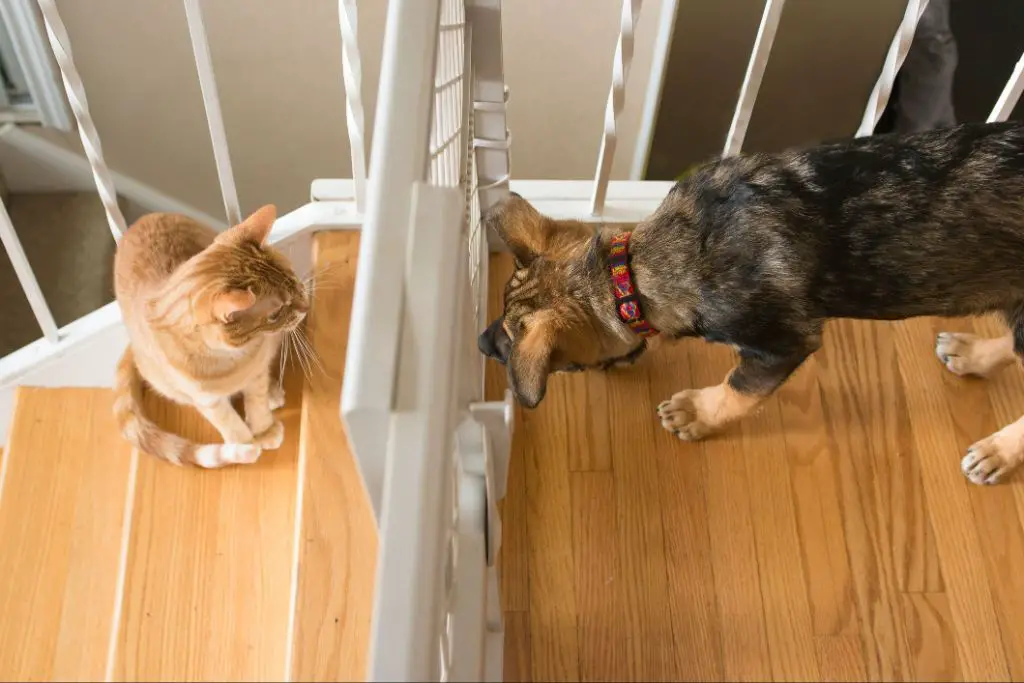Introducing a New Kitten to a Resident Dog
Bringing a new kitten into a home with an existing dog can be challenging but rewarding if done properly. The initial hissing from the kitten is a normal reaction as the animals get accustomed to each other. With some patience and training, the kitten and dog can become comfortable friends.
When a new kitten is first introduced, it’s common for them to feel threatened by the dog and to hiss as a defensive reaction. The hissing communicates that the kitten is scared and overwhelmed. Meanwhile, the resident dog is suddenly dealing with a small, unfamiliar animal that is expressing aggression towards it. This dynamic understandably creates stress for both animals.

The goal of the introduction process should be to gradually build positive associations between the kitten and dog. With time, rewards, and structured interactions, the kitten will feel safer and the hissing behavior will diminish. Proper precautions need to be taken to ensure the kitten has a way to retreat if needed. The dog also needs training on being gentle and socializing properly with the new kitten. With patience on the part of the owner, the two pets can become comfortable, coexisting members of the household.
While initial hissing is expected, owners should not simply leave the pets alone assuming they will work it out. Careful management and training is required to help the kitten and dog overcome their instincts and learn to get along. The effort spent will be well worth it to end up with a harmonious multi-pet home.
Understanding the Hissing Instinct
When introducing a new kitten to a resident dog, it’s very common for the kitten to instinctively hiss at the dog. This hissing is an instinctual reaction driven by fear and lack of socialization, not true aggression. Kittens generally hiss at dogs because they find them large, intimidating, and unfamiliar. The hissing communicates the kitten’s discomfort and functions as a warning to create distance from the perceived threat.
Kittens are small, vulnerable animals that rely on hissing to establish boundaries and protect themselves until they become more socially adept. If a kitten has not been properly socialized with dogs, it will likely view them as scary predators and hiss instinctively. This reaction comes from the kitten’s natural fear response when encountering a much larger animal it doesn’t know or trust yet. The hissing allows the kitten to communicate its discomfort without escalating to aggressive behaviors like attacking or scratching.
It’s important for owners to understand hissing is not the same as outward aggression. While the kitten may be frightened of the dog, the hissing itself aims to avoid conflict rather than provoke it. With proper acclimation done through positive reinforcement training and supervised interactions, the kitten can overcome its instinctive fear and learn to accept the resident dog.
Managing the Initial Interactions
When introducing a new kitten to a resident dog, it’s important to manage their initial interactions carefully to set the relationship up for success. Here are some tips for the initial introduction:

Take it slow. Don’t rush the introduction. Keep the first few sessions brief (5-10 minutes), supervised, and low-key. This will help both animals remain calm.
Use positive reinforcement. Reward both animals with treats and praise for calm, polite behavior in each other’s presence. This builds positive associations.
Give the kitten a safe space. Allow the kitten to retreat to another room or high perch as needed. Having an escape route helps manage stress.
Keep the dog leashed. This allows you to control the dog and prevent chasing. Let the kitten approach and retreat freely.
Watch for body language. Look for relaxed open mouths, upright ears, and curiosity. Hissing, growling, ears back indicate tension. If seeing negative signs, end the session.
Avoid restraining. Don’t force interactions by holding the animals. Let them slowly acclimate and build trust by interacting freely.
Stay positive. Use an upbeat voice and relaxed manner. Your calm demeanor sets the tone. Don’t scold either animal.
Go at their pace. Some pairs will acclimate faster than others. Resume sessions only when both animals appear comfortable. Don’t rush things.
Building Positive Associations
Establishing positive associations between your new kitten and resident dog is essential for building long-term amicable relations. There are several effective ways to cultivate good experiences between the pets:
Feeding time presents opportunities to create positive bonds. Place the food bowls at a reasonable distance from each other and give the pets treats while they eat in close proximity. You can also feed them on opposite sides of a closed door so they associate good feelings with each other’s smells.
Engage the kitten and dog separately in play, then introduce toys like balls or feather wands that they can eventually enjoy together. Reward calm or friendly behavior with treats. Access to fun toys and activities will help them see each other in a positive light.
Give both pets treats when they are near each other or engaged in an activity, like evening relaxation time in the same room. Use especially high-value rewards like pieces of chicken, cheese or meat. This connects the presence of the other animal to good things.
With patience and persistence, regularly repeating these measures will help your kitten and dog form positive bonds and coexist peacefully. Always monitor their interactions closely at first to ensure safety.
Training the Resident Dog
When introducing a new kitten to your resident dog, it is crucial to train the dog to be calm and gentle around the kitten. Many dogs’ natural instincts tell them to chase and play rough with cats, which can be very frightening and dangerous for a tiny kitten. Teaching the dog basic obedience commands like “sit,” “stay,” and “leave it” is a good foundation for redirecting unwanted behavior when the kitten is around.

Use treats, praise, and repetition to positively reinforce calm, gentle behavior from your dog anytime the kitten is nearby. If your dog gets too excited or fixated on the kitten, interrupt this behavior with a command like “sit,” then reward with a tasty treat when they comply. Consistency is key – the more you reinforce good behavior, the quicker your dog will learn. Some additional tips:
- Keep early interactions brief and always supervise.
- If the dog gets overly rambunctious, separate the kitten to a safe area.
- Use a leash to control the dog if needed.
- Verbally correct behaviors like barking or nudging the kitten.
- Reward calm behavior with treats, praise, and affection.
While it may take some time and effort, training your resident dog to respect the new kitten in the home is completely achievable. With proper techniques like redirection, correction, and praise, you can teach your dog to be gentle and help the kitten feel safe and secure.
Providing a Safe Space
It’s important to give your new kitten a dog-free zone where they can eat, sleep, and retreat when they need a break from interacting with your resident dog. This safe space allows the kitten to relax and recuperate, avoiding overstimulation during the initial introduction process. You can create a safe space using the following methods:
Set up a separate room like a spare bedroom or office using a baby gate at the doorway so your dog can’t access the room. This room should contain all of the kitten’s essentials – food and water bowls, litter box, scratching post, toys, and bed. The kitten can spend time in their safe room when needing alone time.
Elevated cat trees and furniture allow your kitten to perch up high, out of the dog’s reach. Place cat trees and cat shelving around your home so your kitten has vertical escape routes. Hideaway boxes with blankets let kittens hide when scared.
Keep your dog out of the kitten’s dedicated feeding area to allow the kitten to eat in peace. Feed your pets in separate rooms or use a baby gate to keep your dog back during mealtimes.
Providing a proper safe space allows your new kitten time to adjust to your resident dog at their own pace, preventing overwhelm and reducing stress.
Using Pheromones and Medications
Pheromone diffusers and anti-anxiety medications can help ease the introduction between a new kitten and resident dog. Pheromone diffusers like Feliway release cat appeasing pheromones into the environment, helping to reduce stress and promote calmness. Plug the diffuser into an outlet in the room where the initial interactions will take place. Let it diffuse for at least 24 hours before introducing the pets.
Your veterinarian may also prescribe anti-anxiety medication for short-term use. Medications like fluoxetine and clomipramine have been shown to reduce anxiety and fear in cats. Make sure to follow your vet’s dosage instructions. Use medication in conjunction with pheromones and positive training techniques for best results. With the right tools, you can help your new kitten feel more comfortable and make new furry friends.
Being Patient
It’s important to have realistic expectations when introducing a new kitten to a resident dog. The process can take weeks or even months before the animals feel fully comfortable around each other. Don’t expect them to be best friends right away.
The kitten’s instinct will be to hiss at the dog at first. This is normal defensive behavior for a young kitten getting used to a new home and animal companion. With time, patience, and positive reinforcement, the hissing should decrease as the kitten becomes more confident and associated the dog with rewards.
Make sure to give both animals ample personal space during the introduction period. Don’t force interactions. Let them sniff each other briefly, then separate. Slowly increase the time they spend together in a controlled setting as they acclimate.
Be prepared for the adjustment period to take several weeks at minimum. Some kittens adapt more quickly than others. But don’t get discouraged by initial hissing and tension. With time, positive reinforcement, and keeping interactions brief and structured, the kitten and dog can form a close bond.
If the hissing persists after several weeks, consult an animal behaviorist. But stay patient, keep interactions positive and rewarded, and understand the process simply takes time in most cases.
Consulting an Expert
If, after several weeks of effort, the cat is still hissing and afraid of the dog, it’s a good idea to seek professional advice. An animal behaviorist or veterinarian who specializes in animal behavior can observe the pets and provide customized training recommendations.
For example, a vet may prescribe anti-anxiety medication for the kitten to help reduce fear and stress during the adjustment period (see https://healthhub.hif.com.au/pet-health/introducing-a-kitten-to-a-dog-how-to-guide). A certified applied animal behaviorist can identify subtle signs of aggression or fear in the pets’ interactions and design a tailored behavior modification plan. With expert guidance, even difficult introductions can often be successful over time.
Don’t give up too quickly. But if you’ve tried everything and the kitten still seems terrified, talk to your vet about whether anti-anxiety medication or a referral to a behaviorist could help. With patience and professional support, the kitten and dog may ultimately become the best of friends.
Ensuring Ongoing Safety
When introducing a new kitten to a resident dog, it’s important to take steps to ensure ongoing safety as the animals get accustomed to each other. Always supervise interactions between the dog and kitten, especially during the initial introduction period. Dogs and cats can engage in play that is too rough or develop antagonistic relationships, so having an owner present to intervene at the first sign of trouble can prevent injuries. Prepare for lifelong management of the multi-pet household. While some dogs and cats get along well after the introduction phase, others may need continued separation at times. Don’t rush expanding freedoms by leaving them alone unsupervised until the owner is confident they have developed a friendly relationship. With patience and proper precautions, a dog and kitten can become the best of friends.
